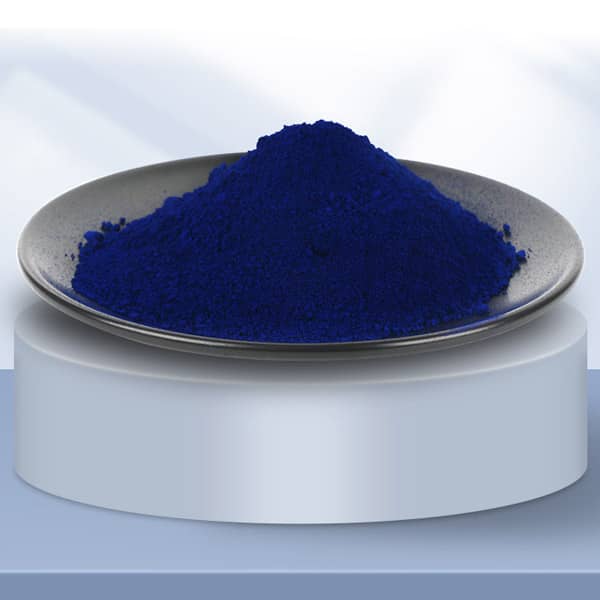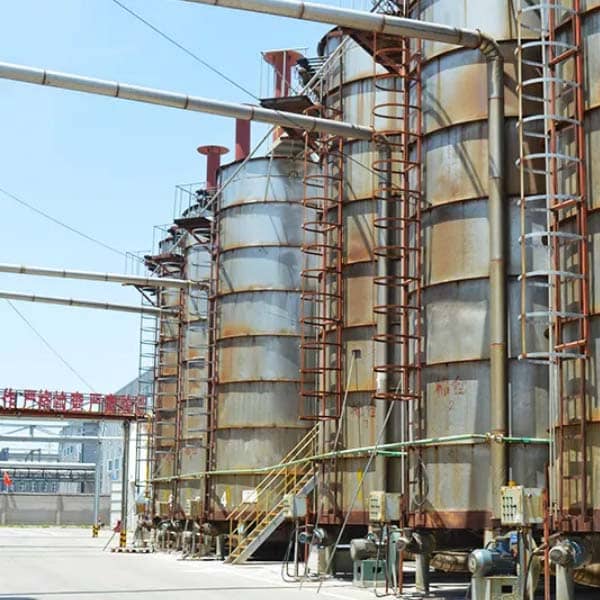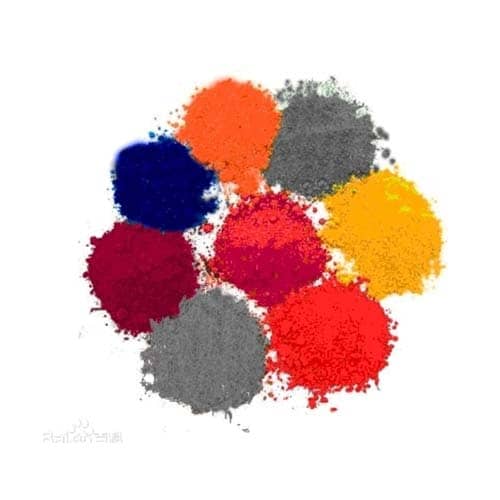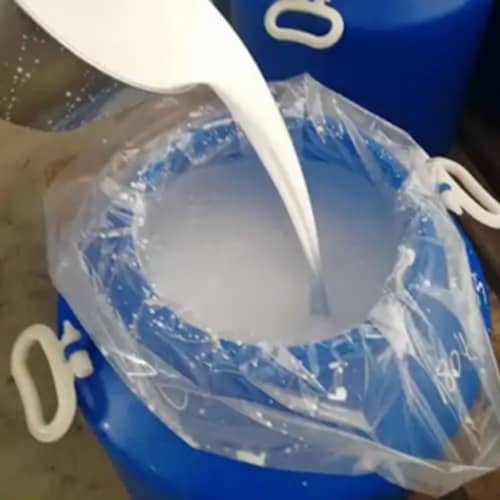Copper phthalocyanine manufacturer: produce excellent organic blue pigment 15
Copper phthalocyanine manufacturer:Introduction to phthalocyanine blue
Copper Phthalocyanine blue also known as Copper Phthal Cyaoine, Heliogen blue B (Heliogen, blueB), pigment blue, cyanine blue, Monastral btueB, etc. Belongs to the phthalocyanine pigment series.
Phthalocyanine blue is mainly composed of finely crystallized copper phthalocyanine, which has a bright blue color and excellent properties of light resistance, heat resistance, acid resistance, alkali resistance, and chemical resistance.
It has strong tinting power, twice that of iron blue and 20 times that of ultramarine, and is the main type of blue pigment.
Phthalocyanine blue is now used not only as a colorant, but also in fields such as organic semiconductors, photoconductors, and photosensitive resin sensitizers. Therefore, copper phthalocyanine has become the most abundant and widely used blue variety among organic materials.
Currently, its demand in the world market is increasing. Acid blue is divided into α type and β type. The industrially produced crude phthalocyanine blue crystal is β-type. This phthalocyanine blue lacks the tinting power of the bluish-green hue. In order to make commercial materials, it must be pigmented to become α-type.
Appearance: bright blue pigment 15 crystal. There are two crystal forms, α and β. Type β is more stable.
Solubility: Insoluble in water and organic solvents.
This product is bright blue powder. Bright color and strong tinting power. Insoluble in water and organic solvents. It has excellent properties and does not produce crystal growth in non-polar solvents, so it can be used in coatings.
China’s national standard for pigments, GB3182-82, was resubmitted for approval in 1995 as GB/T3182-1995. It also uses color classification. Each pigment color has a symbol, such as white for BA, red for HO, and yellow for HU. The code and serial number of the chemical structure, and the model of the pigment, such as rutile titanium white BA-01-03, medium chromium yellow HU-02-02, iron oxide HO-01-01, zinc barium white BA-11-01, Aniline red HO and 2-01, phthalocyanine blue BGS LA-61-02, etc.
Copper phthalocyanine manufacturer:Preparation of phthalocyanine blue
There are many methods for synthesizing this product. The baking method and solvent method are commonly used in industry. The solvent method is taken as an example.
Condensation: Add 2776kg of trichlorobenzene, 1200kg of phthalic anhydride and 1000kg of urea into the kettle, raise the temperature to 160°C, and keep it warm for 2 hours. Add trichlorobenzene, 850kg of urea and 230kg of cuprous chloride for the sixth time. After adding, raise the temperature and keep it for a certain period of time. . Add 867kg of trichlorobenzene and 13.4kg of ammonium molybdate for the third time.
After the addition is completed, the temperature is gradually raised to about 200°C to perform a heat preservation reaction. Then move it into a distillation pot, add liquid caustic soda, and use direct steam to evaporate the solvent. Rinse with water, continue to steam, and dry the material with a film dryer to obtain 1,250kg of crude phthalocyanine blue pigment 15.
Refining: Add 135kg of refined product to 850kg of 98% sulfuric acid and dissolve it, keep it warm at 40°C, then add 17kg of xylene, raise the temperature to 70°C, gradually cool down to 24°C, dilute it in water, let stand for 3 hours, and absorb the upper waste liquid , repeat this three times, neutralize with 30% sodium hydroxide to pH=8~9, stir and boil with direct steam for half an hour, wash with water, dry and grind to obtain 118kg of refined phthalocyanine blue pigment 15.
Copper phthalocyanine manufacturer:Plications of phthalocyanine blue
1. Mainly used for coloring inks, coatings, plastics, rubber and cultural and educational supplies.
2. Used in various solvent-based paints, plastic inks, gravure printing inks, and quick printing inks.
3. Stable β-type green light blue, good dispersion and high hiding power, used in alkyd resin paint.
4. Used for coloring ink, paint, plastic, rubber, paint paste and synthetic fiber pulp
5. Unstable α-type red light blue, strong tinting power, can be used in latex and water-based coatings.
6. Used to make peacock blue ink, used for coloring alkyd paint, etc., and also used for coloring plastic products, cultural and educational supplies, etc.
7. Used for coloring paint, spray paint, ink, plastic, and rubber
8. Mainly used for ink, iron printing ink, paint, painting watercolor, oil paint and paint printing, as well as the coloring of rubber products and plastic products.
9. It is the main variety of blue pigments and is mainly used as colorant in adhesives. The particle size for practical application is generally 0.01~0.1μm, and a particle refinement process must be carried out. The purpose of pigmentation processing is to change the crystal form and reduce the crystal particles. Methods include acid treatment and salt grinding.
Mainly used in the ink industry to manufacture peacock blue ink, which is the main variety of four-color plate printing ink. In the coatings industry, it is used in the manufacture of alkyd enamels, amino baking varnishes, nitrocellulose lacquers and the coloring of clear lacquers. It is also used for coloring plastics, rubber, cultural and educational supplies, linoleum and paint printing, etc.
Copper phthalocyanine manufacturer: Precautions
Category: Toxic Substances
Toxicity classification: low toxicity
Acute toxicity: Oral – Rat
LD: >15000 mg/kg;
Abdominal – Rat LD: > 3000 mg/kg
Flammability hazard characteristics: flammable, fire emit pungent and irritating smoke containing copper and nitrogen oxides
Storage and transportation characteristics: warehouse low temperature, ventilated, dry
Fire extinguishing media: water, carbon dioxide, dry powder, sand
Safety instructions: 22-24/25
RTECS number: GL8510000
TSCA: Yes
Hazardous Substances Data: 147-14-8 (Hazardous Substances Data) [2]
Main irritant effects:
On the skin, it may cause inflammation.
On the eyes, may cause inflammation.
Sensitization: No known sensitizing effects.
Copper phthalocyanine manufacturer: Production process
The copper phthalocyanine content in international crude phthalocyanine blue pigment 15 is 92% to 95%, which is an intermediate product in the manufacture of phthalocyanine blue and phthalocyanine green dyes. There are two ways to make crude phthalocyanine blue pigment 15.
1. Phthalonitrile method
1) Baking method. Mix phthalonitrile and cuprous chloride evenly, put them into an iron plate, put them into a steam-heated closed oven, heat to drive out part of the air, and when the temperature rises to 140°C, an exothermic reaction will occur.
When producing crude phthalocyanine blue pigment 15 , sublimates and smoke will be produced, which must be removed by spraying with water when discharged through the air outlet. It can be discharged after cooling, and the product yield can reach 90% to 93%.
The equipment used in the continuous baking method is a steel horizontal container with a diameter of 1.3 m and a length of 5 m. It has a feeding port and an exhaust port on the top, and the discharge port on the bottom is connected to a jacketed cooling screw conveyor. The container is equipped with a belt conveyor whose copper conveyor belt runs at a speed of 3 m/min.
During operation, the mixture of phthalonitrile, cuprous chloride and anhydrous sodium sulfate is added through the feeding port, falls on the conveyor belt, and is heated electrically under the belt to initiate the condensation reaction. After the reaction starts, heat is released and the temperature can reach 320°C. Nitrogen must be introduced into the container to prevent combustion.
The exhaust gas is discharged from the exhauster and passes through the spray tower to remove sublimates. When the conveyor belt reaches the destination, the reaction has been completed, and the product is shoveled down by the shovel, causing it to fall into the screw conveyor, where it is cooled and sent out.
2) Solvent method. Heat phthalonitrile, copper salt (cuprous chloride or copper chloride), catalyst (molybdenum or titanium, iron compound) in an ammonia-saturated solvent (nitrobenzene or benzene trichloride) to 170 ~220℃, within 10-20 minutes, crude phthalocyanine blue can be generated. After filtering, washing with solvent, then washing with water, and drying, crude phthalocyanine blue is obtained.
For example, disperse 14.8 g copper chloride in 200 g nitrobenzene, vent nitrogen until saturated, raise the temperature to 20-40°C, add 80 g phthalonitrile and 250 g molybdic acid, stir, raise the temperature to 140°C, and react. The color of the object will change from green to yellow, and gradually to reddish brown.
When the temperature reaches 146°C, it begins to exotherm and generate crude phthalocyanine blue pigment 15. Raise the temperature to boiling, stir the reaction for 12 minutes, filter while hot, wash the filter cake with 200 mL of 100°C nitrobenzene, and then wash with 300 mL of methanol and 15 times hot water to obtain crude phthalocyanine blue, the yield is 97.2%.
2. Phthalic anhydride-urea method
Since the raw materials phthalocyanine and urea are cheap and easy to obtain, and the cost is low, they are the main method for producing crude phthalocyanine blue pigment 15. According to the C14 labeling experiment, it is proved that all the carbon atoms in the copper phthalocyanine and the by-product phthalimide come from phthalic anhydride. .
The carbon atoms produced in the reaction come from urea. The phthalic anhydride-urea method can be used to produce crude phthalocyanine blue by baking method or solvent method.
The baking method is to mix phthalic anhydride, urea, cuprous chloride, and ammonium trimolybdate evenly in a certain proportion, or heat and melt them in a reaction pot, then put them into a metal plate, heat them in a closed oven, and heat them at 240 After being kept at ~260°C for several hours, crude phthalocyanine blue can be generated, which can be discharged after cooling.
For example, put 35 kg of phthalic anhydride, 60 kg of urea, 6.9 kg of cuprous chloride, and 1 kg of ammonium trimolybdate into a reaction pot and heat it to 140°C to melt it and stir evenly.
Then it is packed in metal trays, sent to an electric oven to heat up to 240~260℃, kept warm for 4~5 hours, cooled and discharged. 44-46 kg of crude phthalocyanine blue can be obtained, in which the copper phthalocyanine content is about 60%.
3. Pigmentation processing of crude phthalocyanine blue
The purpose of pigment processing of crude phthalocyanine blue is to change the crystal form and reduce the particle size of the crystal, so as to improve the purity and make it have a bright color, high tinting power and applicability.
1) Acid treatment method. Dissolve crude phthalocyanine blue pigment 15 in 98% concentrated sulfuric acid, and then dilute with water to precipitate phthalocyanine blue pigment 15. This method is called the acid solution method.
If the sulfuric acid concentration used is low (about 70%), the crude phthalocyanine blue pigment 15 cannot be dissolved, and only a fine crystalline copper phthalocyanine sulfate suspension is generated, which is then diluted with water to precipitate the phthalocyanine blue. This is called the acid solution method. The phthalocyanine blue pigment 15 obtained by both methods is α-type, with a crystal size of 0.01 to 0.2 μm.
For example, dissolve 100 kg of crude phthalocyanine blue pigment 15 in 700 to 1000 kg of 98% concentrated sulfuric acid, stir, acid dissolve at 30 to 40°C for 4 to 10 hours, add 20 to 30 kg of xylene, and raise the temperature to 70°C to dissolve the xylene Sulfonation.
Cool to 15~25℃, put into 2000~4000 L water, filter, rinse and dry to obtain about 90 kg of metastable alpha phthalocyanine blue pigment 15.
2) Salt grinding method. The crude phthalocyanine blue and inorganic salt are ground together to make the crystal size between 0.01 and 0.2 μm, and the inorganic salt is dissolved in water to obtain phthalocyanine blue. Adding an organic solvent during grinding can turn the product into β-type phthalocyanine blue; grinding without adding an organic solvent or adding polar substances (such as formic acid, acetic acid) can produce α-type phthalocyanine blue. Inorganic salts are used as grinding aids, commonly used include table salt, anhydrous sodium sulfate, anhydrous calcium chloride, etc. Commonly used organic solvents include toluene, xylene, methyl ethyl ketone, tetrachloroethylene, o-dichlorobenzene, N, N-dimethylaniline, ethylene glycol, dipolyethylene glycol, etc.
The salt grinding method can be divided into two processes: ball milling and kneading, depending on the state of the material and the machinery used during grinding.
The ball milling method is used for dry grinding when the amount of solvent is small. In addition to ball mills, the machines used include vertical stirring ball mills, oscillating ball mills, rod mills, etc.
The kneading method is used when a large amount of solvent is used. In addition to the kneader, the machines used include mixers, edge mills, etc.
The salt grinding method is mainly used in industry for the production of β-type phthalocyanine blue pigment 15. For example, 0 kg of crude phthalocyanine blue (containing about 60% copper phthalocyanine blue pigment 15 ), add 12 to 20 kg of anhydrous calcium chloride, 0.8 to 1.2 kg of xylene, 70 to 90 kg of steel balls, and grind it in a vertical stirring ball mill for 3 Take it out after ~4 hours, heat-treat with 3% alkali solution, filter and rinse, then heat-treat with 3% alkali solution, filter, rinse and dry to obtain 6 kg of β-type phthalocyanine blue.
The kneading method requires a high-power heavy-duty kneader, which has a large production capacity of a single machine, low energy consumption, and large batches. A 4000 L kneader is generally equipped with a 300 kW motor. Each unit can produce 700 to 800 kg of finished products per day. The power consumption per ton of finished products is about 6000 kW·h.
However, the kneading method has higher requirements for the specifications of crude phthalocyanine blue pigment 15. The content of copper phthalocyanine in the generally used crude phthalocyanine should reach more than 92%. For example, 400 kg of crude phthalocyanine blue pigment 15 (copper phthalocyanine content is about 92%), 1600-2000 kg of dry salt powder (250-300 mesh), and 300-400 kg of dimer are kneaded for 6 to 8 hours.
When kneading, the materials are required to bond into a hard block, otherwise the kneading efficiency will be greatly reduced. Take out the material, dissolve it in water, filter and rinse. The filtrate is concentrated by vacuum to recover salt and dipolyethylene glycol for recycling, with a recovery rate of over 95%. The filter cake is heat treated with 3% hydrochloric acid, and after filtering, rinsing and drying, about 360 kg of β-type phthalocyanine blue pigment 15 can be obtained.
Copper phthalocyanine manufacturer: Product Development
Domestic backbone enterprises have good equipment and professional personnel, but they lack key technologies, which hinders the improvement of product quality and the development of international markets. Phthalocyanine blue pigment has the characteristics of bright color, strong tinting power, stable performance, light resistance, heat resistance, and good solvent resistance. It is widely used in coatings, inks, rubber, plastics and other industries. Judging from the current development trend of world pigment production, the total annual output of phthalocyanine blue pigments is around 100,000 tons, with annual demand growing at 3%, with China accounting for 20%.
Judging from the overall development trend, the output of developed countries such as Europe and the United States will gradually decline. In addition to large companies in Japan, the United States and other countries, China will become the world’s largest supplier of phthalocyanine blue pigments and has the advantage to occupy a larger market share.
Experts in the industry pointed out that only about 20% of China’s domestic pigment companies have a certain scale, and 80% of the companies are very small. Some domestic manufacturers can produce high-quality crude phthalocyanine blue products, and some are exported. However, most manufacturers not only need to improve the quality, but also have high costs. At the same time, they have not really refined the crude products, and the depth of derivative development is not enough. At present, domestic phthalocyanine blue production has two processes: dry process and wet process. Because the wet process has obvious quality advantages, it accounts for a larger proportion.
The wet method mainly uses two solvents, alkylbenzene and trichlorobenzene. Products produced with trichlorobenzene solvent are restricted in the international market because they contain polychlorinated biphenyls. When alkylbenzene is used as a solvent, the quality is very low. Good, but the cost is too high. How to improve quality and reduce production costs? Delmas believes that the process of using DCT as a solvent currently used in France, India and other countries is the most reasonable choice and is worthy of promotion.
This DCT, specially designed for phthalocyanine blue as a solvent, can not only significantly improve product quality, expand production, and significantly reduce production costs, but the finished product does not contain PCBs at all. Domestic small and medium-sized phthalocyanine blue factories have switched to using DCT as solvent, and the production process can be put into production with only appropriate adjustments. It pointed out that free technical support can be provided in this regard.
When talking about the impact on the domestic phthalocyanine blue industry after joining the WTO, authoritative sources pointed out that the international quality requirements for pigment products are particularly high. If domestic companies, especially small ones, do not improve their technology and processes as soon as possible, it will be difficult to survive. Nowadays, the top priority for enterprises is to integrate with international standards, master advanced technologies and processes, produce high-quality products, develop series of high-quality products, and solve the “three wastes” problem. This is particularly important for the phthalocyanine blue industry.
A certain company’s phthalocyanine blue 15:6 has obtained a national patent. Widely used in electronics, LED displays and other fields. It is at the forefront of its peers in the microencapsulation of pigments.





